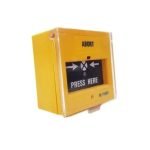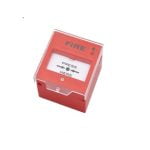Your list is empty, add products to the list to send a request
What Is a CO2 Fire Extinguisher? Complete Guide for Fire Safety

24
Jun
A CO2 fire extinguisher is one of the most common and effective types of fire extinguishers used for electrical and flammable liquid fires. It is known for leaving no residue and being safe for use on sensitive equipment.
This comprehensive guide covers what a CO2 fire extinguisher is, how it works, its best applications, and how it differs from other types like ABC fire extinguishers. We also address how to check its functionality and when to use it. For those seeking a dependable model, the Agni Hunt CO2 Fire Extinguisher offers a reliable solution.
What Is a CO2 Fire Extinguisher?
A CO2 (carbon dioxide) fire extinguisher is a pressurized cylinder filled with carbon dioxide gas. It works by displacing oxygen—the essential component for combustion—and cooling the fire simultaneously.
- Agent Used: Carbon dioxide (CO2)
- Appearance: Usually has a black label or nozzle
- Mechanism: Discharges a high-pressure stream of gas that suffocates the fire
How Does a CO2 Fire Extinguisher Work?
CO2 extinguishers suppress fire by:
- Displacing oxygen around the fire, suffocating the flames
- Cooling the surface of the fuel to prevent re-ignition
Unlike other extinguishers, CO2 leaves no residue, making it ideal for sensitive equipment and clean rooms.
Is CO2 an ABC Fire Extinguisher?
No, a CO2 extinguisher is not an ABC fire extinguisher.
- ABC extinguishers use dry chemical powder to tackle Class A (solids), B (liquids), and C (electrical) fires
- CO2 extinguishers are rated for Class B and C fires only
Avoid using CO2 extinguishers on Class A fires (e.g., paper, wood), as the fire may reignite once the gas dissipates.
Where Are CO2 Fire Extinguishers Used?
CO2 extinguishers are best suited for environments with:
- Electrical equipment (e.g., server rooms, computer labs)
- Flammable liquids (e.g., paint stores, chemical labs)
- Kitchens (for flammable oil fires, not for general Class A fires)
They are common in:
- Offices
- Workshops
- Hospitals
- Industrial zones
- IT data centers
Features of the Agni Hunt CO2 Fire Extinguisher
- Dual-agent extinguisher: Water + CO2 for enhanced coverage
- Effective against Class A and B fires
- ISI-certified, meeting Indian safety regulations
- Durable body and high-discharge hose
Advantages of CO2 Fire Extinguishers
- Leaves no residue – safe for electronics
- Requires no cleanup after use
- Effective in closed spaces where oxygen displacement is possible
- Non-conductive – perfect for live electrical fires
Disadvantages to Be Aware Of
- Not effective on Class A fires involving wood, cloth, or paper
- Limited discharge time (8–30 seconds depending on size)
- Risk of frostbite from the nozzle during discharge
- Should not be used in confined, unventilated spaces due to CO2 buildup
How to Check a CO2 Fire Extinguisher
Unlike stored pressure types, CO2 extinguishers do not have a pressure gauge. Instead, check the following:
- Weigh the extinguisher – verify it matches the rated full weight
- Inspect the nozzle and hose for blockages or cracks
- Look for corrosion or dents on the cylinder
- Ensure hydrostatic testing is up to date (required every 5 years)
- Confirm the inspection tag shows a recent check
Safety Tips for Using CO2 Extinguishers
- Hold the horn by the handle only, not the nozzle (to prevent frostbite)
- Use only in well-ventilated areas
- Stand at least 1.5–2 meters from the fire
- Sweep the nozzle from side to side across the base of the fire
How to Use a CO2 Fire Extinguisher: PASS Method
Follow the 4-step PASS method:
- Pull the pin
- Aim at the base of the fire
- Squeeze the lever slowly
- Sweep from side to side
Maintenance and Refilling
- CO2 extinguishers should be refilled after every use
- Weigh annually to confirm the agent level
- Conduct hydrostatic pressure tests every 5 years
Regular servicing helps ensure your extinguisher is reliable when needed.
Alternative Extinguisher Types to Know
| Type | Best For | Leaves Residue |
| ABC Powder | Class A, B, C | Yes |
| Foam | Class A, B | Minimal |
| Water | Class A only | Yes |
| CO2 | Class B, C (electrical) | No |
CO2 models stand out for their clean discharge and electrical safety.
Conclusion: CO2 Extinguishers Are Vital for Specialized Environments
A CO2 fire extinguisher is an essential safety tool for dealing with flammable liquid and electrical fires. With its clean, residue-free discharge and non-conductive properties, it is ideal for modern environments with delicate equipment.
The Agni Hunt CO2 Fire Extinguisher provides dual-action safety, combining water and CO2 to handle both Class A and B fires effectively.
FAQs
1. Is CO2 an ABC fire extinguisher?
No. CO2 extinguishers are not ABC. They are rated for Class B and C fires (flammable liquids and electrical equipment), but not Class A (combustibles).
2. Where are CO2 extinguishers used?
They are commonly used in offices, data centers, hospitals, workshops, and places with sensitive electrical devices or flammable liquids.
3. How to check CO2 fire extinguisher?
Check by weighing the unit, inspecting the hose and nozzle, and ensuring the cylinder is undamaged. Also confirm hydrostatic test dates are valid.
Don’t wait for a fire to realize you need the right tool.
Equip your space with the Agni Hunt CO2 Fire Extinguisher from fire supplies for clean, powerful, and effective fire protection.



























